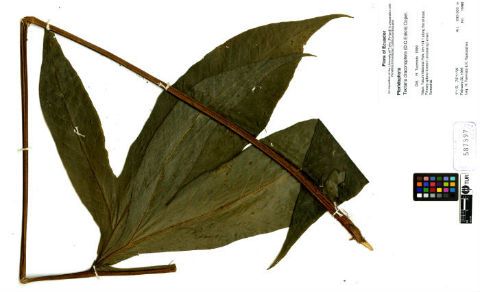Amazon Research Team Wants to Open Its Collections
The University of Turku's Amazon Research Team's (UTU-ART) botanical acquisitions focus especially on ferns and medinilla plants. After spending weeks in the jungle, the researchers’ plant specimen findings end up in the University's Herbarium and databases. The Amazonia is home to innumerable unknown species and therefore it is important to develop the databases.

A specimen belonging to the Amazon Research Team's collections
Among the 3,400 herbaria around the world, the University of Turku's Herbarium reaches the 75th place in terms of the scope of its collections. The University granted funding for the Herbarium to develop the Amazon Research Team's botanical collection management and for solving judicial issues related to the collection that spans over thirty years of the research group's activities. The funding has helped in collection management and database development.
UTU-ART researcher Samuli Lehtonen says that the collection’s specimens provide information on different types of rainforests, for example.
– The plant specimens are placed between newspaper sheets and they are tagged with a unique number. All related information is written down in notebooks. Plants collected in the jungle decompose rapidly, so they are lathered with alcohol and stored in airtight bags, describes Lehtonen.
Later, the specimens are dried and their information is entered in the database. A database information label is attached to the specimens. The plants then wait for their turn to be affixed onto sheets of paper, after which they can be filed in the Herbarium’s collections.

UTU-ART researcher Hanna Tuomisto collecting samples (Photo: Kalle Ruokolainen)
Judicial Issues Challenging Collection
The University funding helps develop the Herbarium’s archival of specimens and use of databases. A new issue is the Nagoya Protocol, which regulates access to genetic resources and the sharing of benefits arising from their utilisation.
– The decrees include obligations imposed by the European Union. Additionally, Finnish law also sets certain regulations on data administration and reporting. The research must benefit the nation from whose territory the plant specimens have been gathered.
To clarify the judicial issues, the Herbarium has hired a lawyer to facilitate building database systems that conform to the Protocol's obligations and to manage the collections as described in legislation.
Funding Helps Archiving and Database Development
With the help of the collections, researchers can, for example, compare unrecognised species. If a discovered species has not been described anywhere in the world, it is described as a new species.
The University's Amazon Research Team has its own database for its collections. Additionally, the Herbarium's collections are stored in the Kotka collection management system of the Finnish Museum of Natural History.

UTU-ART researcher Samuli Lehtonen presents archived specimens. (Photo: Krista Kalaja)
– Via the Kotka database, the specimens gain international visibility and we are able to internationally collaborate and analyse the specimens, says Lehtonen.
The funding is necessary, as the specimens collected over the course of three decades need to be affixed onto sheets and filed into the collections.
– We lacked the resources to affix all the specimens in the time frame we hoped for. Thanks to the funding, we have hired a person to affix the plant specimens and speed up their transfer into the databases, says Lehtonen.
The databases also play a role in avoiding overlapping plant naming. Additionally, the digitised material does not need to be sent from one herbarium to another, which is always a risk as the specimens can disintegrate or disappear.
Text: Krista Kalaja
Translation: Mikko Suhonen
Photos: Kalle Ruokolainen and Krista Kalaja